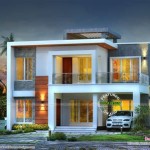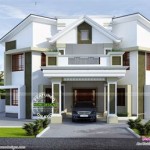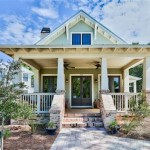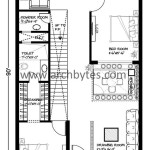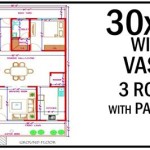Floor Plan: 80 Sqm Bungalow House Design in 3D
The allure of bungalow living continues to captivate homeowners seeking simplicity, accessibility, and a connection to the surrounding landscape. An 80 square meter bungalow house design presents a unique challenge and opportunity to maximize space and functionality within a compact footprint. The 3D visualization of such a design allows for a comprehensive understanding of the spatial arrangement, material choices, and overall aesthetic impact before construction commences. This article will explore key considerations in designing an 80 sqm bungalow house, highlighting aspects of floor plan optimization and the value of 3D representation.
Creating a successful 80 sqm bungalow design necessitates careful planning and prioritization. Every square meter must contribute to the overall functionality and livability of the home. This typically involves strategic placement of rooms, efficient use of corridors, and the integration of multi-functional spaces. The availability of 3D modeling software provides homeowners and architects with the ability to experiment with different layouts and design options in a virtual environment, leading to more informed decisions and a more satisfying final product.
Optimizing Space in an 80 Sqm Bungalow
One of the primary considerations in designing a compact bungalow is the efficient use of space. This requires a thoughtful approach to room sizes, furniture placement, and storage solutions. An open-plan living area, combining the living room, dining area, and kitchen, can create a sense of spaciousness and promote social interaction. However, careful zoning within this open area is essential to define distinct functional zones and maintain a degree of separation.
Corridors should be minimized to avoid wasting valuable floor space. Where corridors are unavoidable, consider incorporating built-in storage solutions, such as bookshelves or linen closets, to maximize their utility. In smaller bedrooms, built-in wardrobes and beds with integrated storage can help to declutter the space and create a more organized environment. Consider the placement of doorways and windows to ensure optimal natural light and ventilation throughout the house. Large windows can also visually expand the space and connect the interior with the surrounding landscape.
Multi-functional furniture is another key element in optimizing space. Sofa beds, foldable tables, and storage ottomans can serve multiple purposes, adapting to different needs and maximizing the usability of each room. Vertical storage solutions, such as tall bookshelves and wall-mounted cabinets, can also help to free up floor space and create a more organized and visually appealing interior.
Furthermore, strategic use of mirrors can create the illusion of more space and reflect natural light, making rooms feel brighter and more airy. Light-colored walls and flooring can also contribute to a sense of openness and spaciousness. The choice of flooring materials can also impact the perceived size of a room. Using the same flooring throughout the main living areas can create a seamless transition and visually expand the space.
Floor Plan Considerations for an 80 Sqm Bungalow
The floor plan is the foundation of any successful house design, and this is particularly true for a compact bungalow. The floor plan should reflect the occupants' lifestyle and needs, while also taking into account factors such as site orientation, climate, and budget. A typical 80 sqm bungalow might include two or three bedrooms, one or two bathrooms, a living room, a dining area, and a kitchen. The specific layout and arrangement of these spaces will depend on the individual preferences of the homeowner.
When designing the floor plan, it is important to consider the flow of traffic between different rooms. The layout should allow for easy and convenient movement throughout the house, avoiding bottlenecks and creating a comfortable living environment. The kitchen should be located near the dining area for convenient meal preparation and serving. Bedrooms should be situated away from the main living areas to ensure privacy and quiet.
The placement of bathrooms is also an important consideration. Bathrooms should be easily accessible from all bedrooms and living areas. If possible, consider including two bathrooms in the design – one for the master bedroom and another for guests or family members. The inclusion of a laundry area is also a practical addition to any bungalow design. This space can be integrated into the bathroom or located in a separate utility room.
Outdoor living spaces, such as patios or decks, can significantly enhance the functionality and enjoyment of a bungalow. These spaces can provide a place for relaxation, entertainment, and outdoor dining. The orientation of the bungalow on the site should be carefully considered to maximize exposure to sunlight and minimize exposure to harsh weather conditions. A well-designed floor plan will optimize natural light and ventilation, reducing the need for artificial lighting and air conditioning.
Accessibility is another crucial factor to consider when designing a bungalow floor plan. Bungalows are often favored by individuals with mobility issues due to their single-story layout and lack of stairs. The floor plan should be designed to accommodate wheelchairs and other mobility aids, with wide doorways, spacious hallways, and accessible bathrooms. Ramps can be added to entrances to eliminate steps and provide easy access to the house.
The Benefits of 3D Visualization in Bungalow Design
3D visualization has revolutionized the way houses are designed and constructed. By creating a virtual model of the bungalow, homeowners and architects can gain a more realistic understanding of the spatial arrangement, material choices, and overall aesthetic impact of the design. This allows for informed decisions to be made before construction commences, reducing the risk of costly mistakes and ensuring a more satisfying final product.
3D models can be used to experiment with different design options and explore various layout possibilities. Homeowners can visualize how furniture will fit into the space, how natural light will affect the interior, and how different color schemes will look in reality. This level of detail allows for fine-tuning of the design and ensures that the final product meets the homeowner's specific needs and preferences.
Furthermore, 3D visualizations can be used to communicate the design to contractors and other stakeholders involved in the construction process. A clear and accurate 3D model can help to avoid misunderstandings and ensure that the building is constructed according to the intended design. This can save time and money and reduce the risk of errors and delays. 3D models also facilitate the process of obtaining building permits and approvals from local authorities.
The use of 3D visualization software also allows for the creation of rendered images and virtual tours of the bungalow. These images and tours can be used for marketing purposes, allowing potential buyers to experience the house before it is even built. This can be a powerful tool for selling off-plan properties and attracting buyers who are looking for a modern and stylish bungalow design. The ability to virtually walk through the property offers an immersive experience that static floor plans cannot replicate.
Finally, 3D modeling software allows for the integration of sustainable design elements into the bungalow. Architects can simulate the performance of different building materials and systems, such as solar panels, insulation, and ventilation, to optimize energy efficiency and reduce the environmental impact of the house. This can help homeowners to save money on energy bills and create a more sustainable and environmentally friendly living environment.
In conclusion, designing an 80 sqm bungalow house requires careful planning, attention to detail, and a strategic approach to space optimization. The floor plan is the foundation of the design, and it should be tailored to the specific needs and preferences of the homeowner. The use of 3D visualization tools can greatly enhance the design process, allowing for experimentation, communication, and informed decision-making. By carefully considering these factors, it is possible to create a compact and stylish bungalow that offers a comfortable and functional living environment.

80 Sq M Modern Bungalow House Design With Roof Deck Engineering Discoveries

80 Sq M Modern Bungalow House Design With Roof Deck Engineering Discoveries

A Simple Small House Design 80 Sqm Dream Tiny Living

Modern Bungalow House With 3d Floor Plans And Firewall Pinoy Designs

Small House Design Idea 8x10 Meters 80sqm With Three Bedrooms

Small House Plan 8 X 10 M 80 Sq Design 4

Gorgeous Single Story House With 3d Floor Plan Pinoy Eplans

80sqm 3 Bedroom House Plans With Photos Plandeluxe

Free 3 Bedrooms House Design And Lay Out

House Plans Choose Your By Floor Plan Djs Architecture

